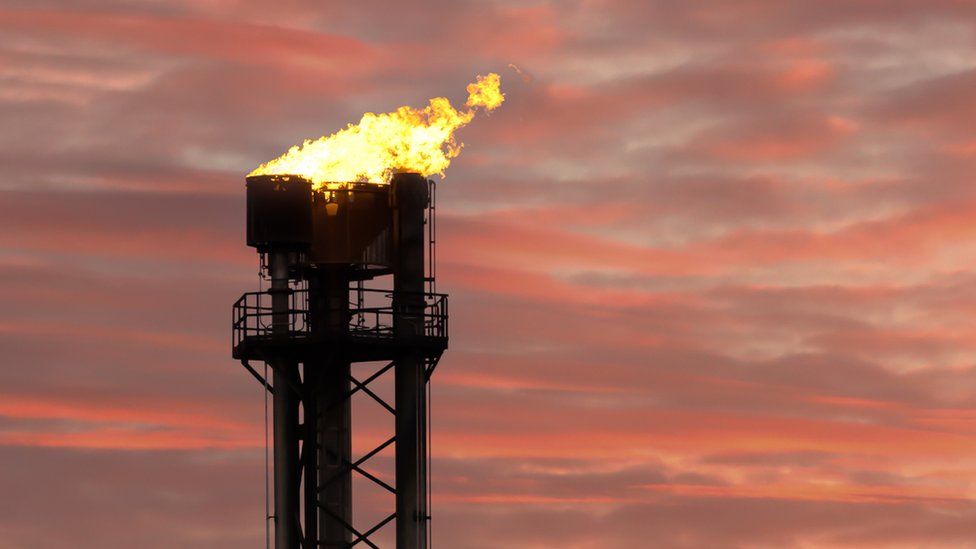ARTICLE AD BOX
 Image source, Getty Images
Image source, Getty Images
Flaring and venting methane gas is a routine part of oil extraction.
By Jonah Fisher
BBC Environment Correspondent
The UK government is allowing the fossil fuel industry to waste large amounts of gas, according to a leading environmental think-tank.
Green Alliance says oil and gas companies are wasting enough methane to power more than 700,000 UK homes.
It says high energy prices mean more of the gas should be captured and used.
A spokesperson for UK oil and gas companies rejected that, saying it was not profitable to capture all of it.
Scientists say that methane is, alongside carbon dioxide, one of the main contributors to global warming.
"It's a scandal," Dustin Benson of Green Alliance told BBC News. "The government should force these companies to capture the methane they're currently wasting."
UK methane emissions have fallen significantly since 1990 but in recent years progress has slowed.
"The big attraction for reducing methane is you get a big bang for your buck very quickly in terms of tackling climate change," Professor Dave Reay from the University of Edinburgh told BBC News.
"If we cut emissions very quickly we'll see that impact in terms of reduced warming in the atmosphere very quickly."
Most UK methane emissions now come from farming and waste disposal. While reducing methane leakage from those sources is complex, cutting down on it in the oil and gas production that accounts for 11% of emissions is considered low-hanging fruit.
The vast bulk of the UK oil and gas industry is located offshore in the North Sea. Methane is brought to the surface as a routine part of production. Part of it is flared (burnt); vented (released) or leaks out of pipes.
The North Sea Transition Authority regulates the UK's oil and gas industry and has published a series of guidelines on methane emissions. They include the goal of "zero routine flaring and venting" by 2030 and states that "flaring and venting and associated emissions should be at the lowest possible levels in the circumstances." But critics say there's not enough monitoring or enforcement.
In October 2021 the International Energy Agency (IEA) calculated that 45% of global methane emissions could be stopped at no net cost to the oil and gas companies.
Now, stopping emissions should even be profitable, says Green Alliance; Russia's invasion of Ukraine has sent gas prices soaring, meaning it should now be cost-effective for almost all the wasted gas to be captured and used.
"We estimate that around 750,000 homes could be heated this winter if we stopped flaring and instead piped that gas into peoples homes," said Mr Benson.
"In terms of leakage it's a bit more unclear but we think its between 100,000 and 150,000 homes that is just being lost into the atmosphere."
Both the fossil fuel industry and the government says it's not that simple and point at steady reductions in methane emissions in recent years as proof of progress.
"The volumes that are being vented and flared are not large in the context of UK greenhouse gas emissions," says Charles McAllister from UK Onshore Oil and Gas.
"Some of these facilities are quite old. To repurpose them to capture what the Environment Agency would call "de minimis" (lacking importance) volumes of methane is not economically viable."
A spokesperson from the Department of Business Energy and Industrial Strategy said the government is "working diligently with regulators to drive down methane emissions from oil and gas operations in the North Sea."
Image source, BBC/Gwyndaf Hughes
Image caption,The Clean Air Task Force use an optical gas imaging camera to spot methane emissions
A small fraction of the UK's methane emissions come from onshore drilling and fossil fuel infrastructure.
The BBC accompanied the Clean Air Task Force, an international environmental organisation, on a hunt for the gas in rural Hampshire.
From a public footpath, Theo Humann pointed what looked like a chunky camcorder through a metal fence at a small oil well.
It's an optical gas imaging camera, which measures heat differences and infrared energy.
On Mr Humann's screen the methane showed up as a distinctively coloured disturbance emerging from a tall pipe.
Image source, BBC/Gwyndaf Hughes
Image caption,The camera shows up gas emissions that are not visible with the naked eye
"This is an old well so probably not connected to a gas grid or a processing facility. So the easiest option for the site operator is just release it," said Humann.
"The technology exists to capture the gas that's being vented and emitted from the various equipment that we see on this site," Clean Air Task Force campaign manager James Turrito said outside the gate to the oil well. "This is absolutely avoidable."

 2 years ago
79
2 years ago
79








 English (US) ·
English (US) ·